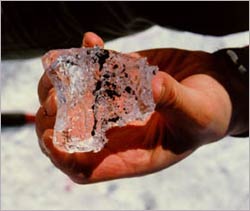Discovering a meteorite existed before the Sun was formed?
According to a new study published in Science, a meteorite falling in Canada may contain components formed in a cold cloud before the solar system was born.
 (Photo: HTV) On January 18, 2000, a fireball passed through the Canadian sky and the remains of the meteorite fell on British Columbia, on Tagish Lake. Samples were quickly recovered on tape, giving scientists the opportunity to study a ' fresh ' material.
(Photo: HTV) On January 18, 2000, a fireball passed through the Canadian sky and the remains of the meteorite fell on British Columbia, on Tagish Lake. Samples were quickly recovered on tape, giving scientists the opportunity to study a ' fresh ' material.
The first isotopic analysis showed that Tagish lake meteorites made of carbone chondrite contained a very primitive material.
In 2002, researchers discovered the presence of tiny carbon droplets in this meteorite. So far, researcher Keiko Nakamura-Messenger and colleagues from Johnson Space Center (USA) have confirmed that these carbon nanospheres do not exist on Earth.
The researchers explained that these nanospheres contain deuterium and nitrogen forms that do not form on Earth, but in a very cold environment at 10 degrees or 20 degrees Kelvin. They may have formed in cold molecular clouds like clouds that existed before the Sun shone.
The Tagish meteorite offers a rare opportunity for scientists to study the solar system's original materials without launching probes to retrieve them.
Power
- 4.5 billion year old meteorite revealed life on Mars
- Meteors show signs of life outside of Earth
- USA: Discovering a 630 kg meteorite
- Rare meteorites are forgotten for more than a century
- Detecting meteor mass in China
- Find the oldest Earth's crater
- Find the largest meteorite pieces in Russia
- Flocking to find meteorite fragments in Russia
- The meteorite explosions
- A meteorite as big as the Great Pyramid is about to fly over the Earth
- What is Chondrit meteorite?
- The oldest meteorite is about the same age as the Solar System
 Van Allen's belt and evidence that the Apollo 11 mission to the Moon was myth
Van Allen's belt and evidence that the Apollo 11 mission to the Moon was myth The levels of civilization in the universe (Kardashev scale)
The levels of civilization in the universe (Kardashev scale) Today Mars, the sun and the Earth are aligned
Today Mars, the sun and the Earth are aligned The Amazon owner announced a secret plan to build a space base for thousands of people
The Amazon owner announced a secret plan to build a space base for thousands of people